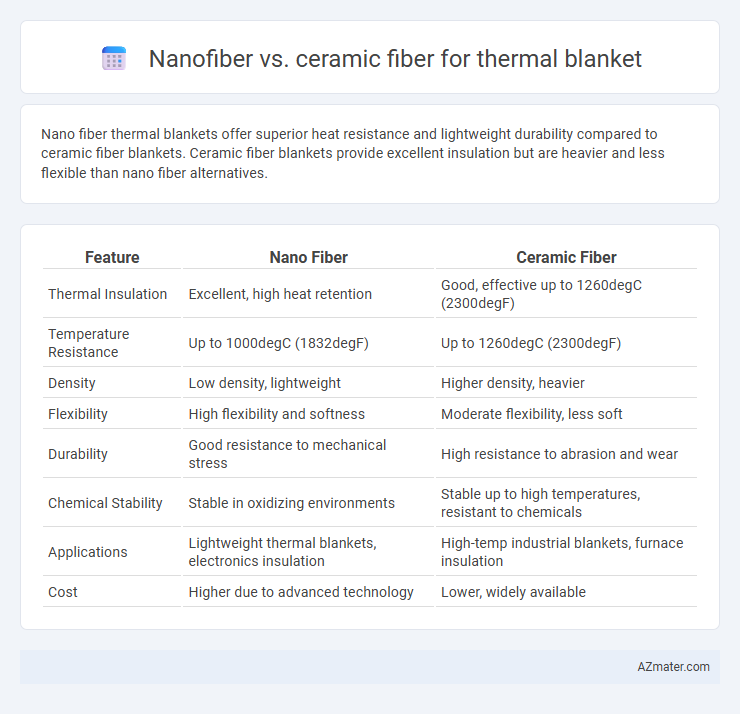Nano fiber thermal blankets offer superior heat resistance and lightweight durability compared to ceramic fiber blankets. Ceramic fiber blankets provide excellent insulation but are heavier and less flexible than nano fiber alternatives.
Table of Comparison
| Feature | Nano Fiber | Ceramic Fiber |
|---|---|---|
| Thermal Insulation | Excellent, high heat retention | Good, effective up to 1260degC (2300degF) |
| Temperature Resistance | Up to 1000degC (1832degF) | Up to 1260degC (2300degF) |
| Density | Low density, lightweight | Higher density, heavier |
| Flexibility | High flexibility and softness | Moderate flexibility, less soft |
| Durability | Good resistance to mechanical stress | High resistance to abrasion and wear |
| Chemical Stability | Stable in oxidizing environments | Stable up to high temperatures, resistant to chemicals |
| Applications | Lightweight thermal blankets, electronics insulation | High-temp industrial blankets, furnace insulation |
| Cost | Higher due to advanced technology | Lower, widely available |
Introduction to Thermal Blankets: Nano Fiber vs Ceramic Fiber
Thermal blankets made from nano fiber offer superior thermal insulation due to their high surface area and low thermal conductivity, making them ideal for advanced temperature control applications. Ceramic fiber blankets provide excellent heat resistance and stability at extreme temperatures, commonly used in furnaces and industrial kilns. Comparing nano fiber to ceramic fiber, nano fiber blankets deliver enhanced flexibility and lighter weight, while ceramic fibers excel in durability and refractory performance.
Composition and Structure: Nano Fiber vs Ceramic Fiber
Nano fibers in thermal blankets consist of ultrafine polymer or carbon-based fibers with diameters typically below 100 nanometers, forming a highly porous, yet tightly interwoven network that enhances thermal insulation through reduced thermal conductivity and minimal fiber-to-fiber contact. Ceramic fibers, composed of alumina, silica, or alumina-silica blends, boast micro-scale diameters ranging from 1 to 5 microns, creating a rigid, refractory mat structure designed for high-temperature resistance and mechanical stability. The nanofiber's superior surface area and flexibility offer enhanced thermal barrier performance at lower temperatures, whereas ceramic fibers provide robustness and durability in extreme thermal environments.
Thermal Insulation Performance Comparison
Nano fiber thermal blankets exhibit superior thermal insulation performance compared to ceramic fiber blankets due to their ultra-fine fiber diameter and higher surface area, which significantly reduce heat conduction and convection. Ceramic fiber blankets provide excellent high-temperature resistance but typically have higher thermal conductivity, resulting in less efficient insulation at lower temperatures. Overall, nano fiber blankets offer enhanced insulation efficiency, making them ideal for applications requiring lightweight and effective thermal barriers.
Temperature Resistance Capabilities
Nanofiber thermal blankets exhibit superior temperature resistance capabilities, often withstanding continuous exposure up to 1,200degC due to their fine fiber diameter and high surface area, which enhance thermal insulation performance. Ceramic fiber thermal blankets exceed temperature resistances of 1,400degC, benefiting from their inorganic composition and crystalline structures that provide exceptional thermal stability and resistance to thermal shock. The choice between nanofiber and ceramic fiber thermal blankets depends on specific application temperature requirements, with ceramic fibers preferred for ultra-high temperature environments and nanofibers favored for moderate high-temperature insulation with lightweight and flexible properties.
Mechanical Strength and Flexibility Differences
Nano fiber thermal blankets exhibit superior mechanical strength due to their finely woven structure, offering enhanced durability under stress compared to ceramic fiber blankets. Ceramic fiber blankets, although lightweight, tend to be more brittle and less flexible, making them prone to cracking or fracturing under mechanical strain. The flexibility of nano fiber blankets enables better conformity to complex shapes, improving insulation effectiveness in dynamic applications.
Weight and Thickness Considerations
Nano fiber thermal blankets offer significantly lower weight and thinner profiles compared to ceramic fiber counterparts, enhancing portability and ease of handling. The ultrafine nano fibers provide superior insulation performance with less bulk, resulting in blankets optimized for applications where minimizing thickness is critical. Ceramic fiber blankets, while effective in high-temperature resistance, tend to be heavier and thicker, which may limit their suitability for lightweight thermal protection needs.
Energy Efficiency and Heat Loss Reduction
Nano fiber thermal blankets exhibit superior energy efficiency and heat loss reduction compared to ceramic fiber blankets due to their ultra-fine fiber diameter, which enhances insulation performance by minimizing heat conduction and convection. The high surface area-to-volume ratio of nano fibers creates a dense, lightweight barrier that effectively traps air and reduces thermal bridging, resulting in lower energy consumption for temperature regulation. In contrast, ceramic fibers, while durable and heat-resistant, generally possess coarser fibers that allow higher heat transfer, making nano fiber blankets more advantageous for advanced thermal insulation applications.
Durability and Longevity of Thermal Blankets
Nano fiber thermal blankets exhibit superior durability due to their fine fiber structure, which enhances resistance to wear, tear, and thermal degradation compared to ceramic fiber blankets. Ceramic fiber thermal blankets provide excellent high-temperature insulation but tend to become brittle and degrade faster under cyclic thermal stresses. The longevity of nano fiber blankets is significantly higher, making them a more reliable choice for applications demanding prolonged thermal protection and mechanical resilience.
Safety and Environmental Impact
Nano fiber thermal blankets offer superior safety due to their non-toxic composition and low fiber shedding, reducing respiratory hazards compared to ceramic fiber blankets, which often release harmful respirable fibers during use. Environmentally, nano fibers are typically produced using greener manufacturing processes and are more biodegradable, whereas ceramic fibers pose disposal challenges due to their refractory nature and potential for long-term environmental persistence. Choosing nano fiber blankets significantly minimizes health risks and environmental impact in high-temperature insulation applications.
Cost-Effectiveness and Application Suitability
Nano fiber thermal blankets offer superior insulation performance with higher cost due to advanced manufacturing processes, making them ideal for high-precision applications in aerospace and electronics. Ceramic fiber blankets provide excellent heat resistance at a lower price point, suitable for industrial furnaces, kilns, and thermal insulation in heavy industries. Cost-effectiveness favors ceramic fibers for large-scale, high-temperature environments, while nano fibers are preferred where lightweight, flexibility, and thermal efficiency are critical.

Infographic: Nano fiber vs Ceramic fiber for Thermal blanket
 azmater.com
azmater.com